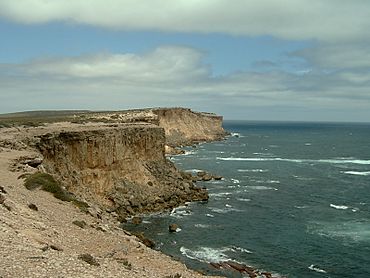Point Labatt Aquatic Reserve facts for kids
Quick facts for kids Point Labatt Aquatic ReserveSouth Australia |
|
|---|---|
|
IUCN Category Ia (Strict Nature Reserve)
|
|

Looking east from visitors’ observation area at Point Labatt.
|
|
| Nearest town or city | Streaky Bay. |
| Established | 1988 |
| Area | 2.38 km2 (0.9 sq mi) |
| Managing authorities | Primary Industries and Regions SA (PIRSA) |
| See also | Protected areas of South Australia |
Point Labatt Aquatic Reserve is a special ocean area in South Australia. It's a marine protected area, which means it's a part of the ocean kept safe for nature. This reserve is located in the waters of the Great Australian Bight, right next to the west coast of the Eyre Peninsula at a headland called Point Labatt.
Protecting Australian Sea Lions
This aquatic reserve was created to protect a very important breeding colony of Australian sea lions. These amazing animals are a special type of sea lion found only in Australia. They are considered 'rare' and need our help to survive.
The reserve was first set up in 1988. It was updated in 2007 to make sure the sea lions continue to be protected. The main goal is to keep this area safe for them to live and raise their young.
What is Protected?
To keep the sea lions safe, certain rules are in place. People are not allowed to enter some parts of the reserve. Also, no fishing or collecting of any marine animals or plants is allowed here. This helps make sure the sea lions have plenty of food and a peaceful home.
The reserve stretches out into the ocean for about 1.9 kilometres (1 nautical mile) from the coastline. It covers an area of about 2.38 square kilometres. This makes it a significant safe zone for the sea lions.
Part of a Larger Park
Since 2012, Point Labatt Aquatic Reserve has also been part of a bigger protected area. It is inside a 'restricted access zone' within the West Coast Bays Marine Park. This means it's a very important and sensitive part of the larger marine park system.
Global Protection Status
The Point Labatt Aquatic Reserve is recognized internationally for its high level of protection. It is classified as an IUCN Category Ia protected area. This means it's a 'Strict Nature Reserve'. These reserves are set aside mainly for scientific research or environmental monitoring. They are areas where human disturbance is kept to a minimum.


